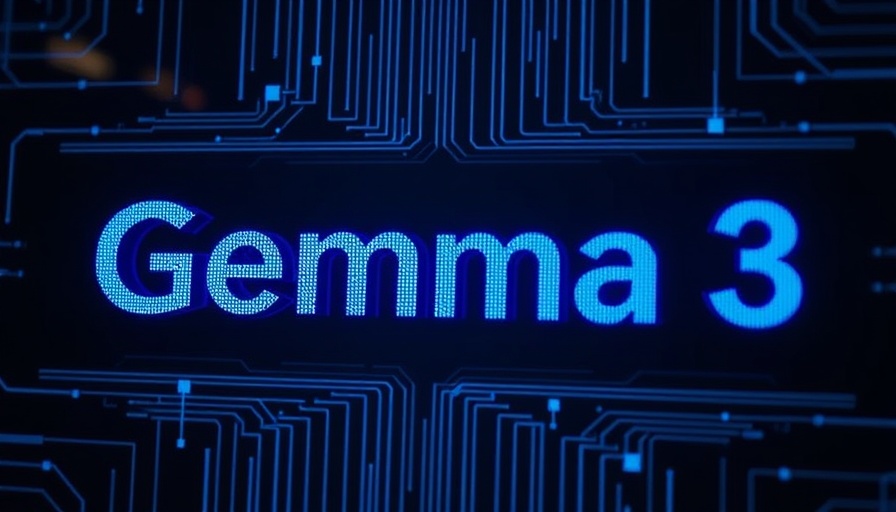
Introducing Google's Game-Changing AI Model: Gemma 3
In a rapidly evolving landscape of artificial intelligence, Google presents us with its latest innovation: Gemma 3, an open-source AI model optimized to run on a single GPU. Unlike traditional AI models, which often require substantial computing power from multiple servers, Gemma 3 focuses on efficiency without compromising performance. This move mirrors a growing trend in AI development, emphasizing the need for adaptable models that can operate effectively across various platforms, from powerful data centers to consumer-grade smartphones.
What Makes Gemma 3 Stand Out?
Gemma 3 introduces a vast context window of 128,000 tokens, an upgrade from its predecessor's mere 8,192 tokens. This expansion allows developers to input and process significantly more data, enhancing the model's capabilities. Designed primarily for developers, Gemma 3 can be utilized for a variety of environments—whether it be a data center application or a lightweight mobile app. This versatility positions Gemma 3 at the forefront of AI advancement, supporting a wide range of applications like text processing, image recognition, and even video analysis.
Efficiency Meets Performance
Gemma 3 is categorized based on its parameter size, featuring models ranging from a trim 1 billion parameters for straightforward tasks to a robust 27 billion parameters for complex computations. This tiered approach means developers can choose a model that best suits their hardware. The smallest models can operate with less than a gigabyte of memory, while larger configurations require substantially more. This kind of flexibility has become essential as demand grows for lightweight AI that can seamlessly fit into personal and professional environments.
The Theory Behind the Performance: The Gemini Foundation
The new model is underpinned by Google's proprietary Gemini 2.0 technology, giving Gemma 3 a unique advantage in the crowded AI marketplace. Unlike other AI models that demand extensive hardware resources, Gemma 3 is tailored to use a single Nvidia H100 accelerator effectively. In comparative tests conducted using the Elo metric—a measure for user preference—Gemma 3 performed favorably against notable competitors like Meta's Llama3 and OpenAI’s models, showcasing its impressive capabilities in chat situations and beyond.
Security Features: The Introduction of ShieldGemma 2
Further enhancing its appeal is the integration of ShieldGemma 2, an innovative solution for image safety. This layer of security enables developers to filter content across dangerous, sexual, or violent categories, demonstrating a responsible approach to AI development amidst rising concerns about harmful content. This move not only safeguards users but also aligns with Google's commitment to ethical practices within tech innovation.
Exploring the Gemmaverse
A significant aspect of Gemma 3 is the Gemmaverse, a community of developers and enthusiasts sharing tools and applications built with the Gemma models. With over 100 million downloads and a range of more than 60,000 community-generated models, the Gemmaverse reflects a thriving ecosystem that supports experimentation and innovation. By granting open access to these models through platforms like Kaggle and Hugging Face, Google fosters an environment of creativity where diverse AI applications can flourish.
The Future of AI Development with Gemma 3
Gemma 3's launch represents a critical step toward democratizing access to advanced AI technology. Its intrinsic capacity for customization allows developers to fine-tune the model, enabling specific adaptations to meet unique project needs. This is complemented by comprehensive integration options with tools familiar to the developer community. As AI development continues to evolve, Gemma 3 stands as a testament to innovation focused on accessibility, encouraging a lifelike interaction across various hardware and software environments.
In conclusion, Google’s Gemma 3 AI model is poised to reshape the landscape of artificial intelligence. By optimizing for single GPU use, offering flexible models, and introducing responsible safety features, it invites developers to push the boundaries of what is achievable with AI technology. Enthusiasts and developers alike should delve into this transformative tool, explore its capabilities, and contribute to the ever-expanding Gemmaverse.
 Add Row
Add Row  Add
Add 




Write A Comment